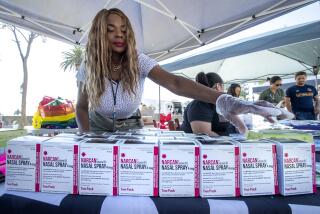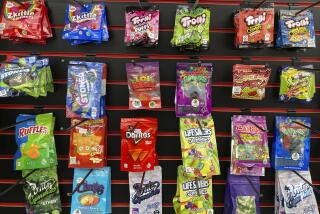U.S. 8th-Grader Drug Use Seen Increasing : Narcotics: While consumption among seniors continues to drop, study findings on 13- and 14-year-olds shows hardwon gains may be lost.
WASHINGTON — Drug use among eighth-graders increased unexpectedly last year--a development that may be a warning to the nation of the human cost of shifting attention from the war on drugs, according to a respected University of Michigan study released Tuesday.
The annual survey of nearly 50,000 eighth-, 10th- and 12th-grade students nationwide found that 13- and 14-year-olds reported “modest but statistically significant” increases from 1991 and 1992 in the use of marijuana, cocaine, crack, LSD, other hallucinogens, stimulants and inhalants.
The survey also found that the use of LSD among high school seniors last year reached its highest level since 1985. Use of illicit drugs by seniors continued to decline overall, however, indicating undeniable progress in reducing drug use among young Americans, according to Lloyd Johnston, the principal investigator for the study.
“But we may now be in danger of losing some of that hard-won ground as a new, more naive generation of youngsters enters adolescence and as society eases up on its many communications to young people of all ages about drugs,” Johnston said.
“As each new generation of students is about to enter high school, they need to understand that alcohol and other drug abuse can put their futures and their lives at stake,” said Health and Human Services Secretary Donna Shalala.
The University of Michigan study, paid for by a $3-million grant from the National Institute on Drug Abuse, a Health and Human Services agency, said that the increased use of drugs among eighth-graders may be tied to a change in their perception of the dangers of the drugs and in their personal attitude toward drugs.
“The drug abuse issue has pretty much ‘fallen off the screen’ in this country, both figuratively and literally,” Johnston said. “Ever since the buildup to the (Persian) Gulf War, political leaders and the press talk about it less, television networks have backed off on their prime-time placement of anti-drug ads and, in general, national attention has moved away from the issue.”
The number of eighth-graders who said that they had used marijuana at least once in their lifetimes rose from 10.2% in 1991 to 11.2% in 1992. The study found a similar increase in the number of eighth-graders who reported using the drug over the last year, from 6.2% in 1991 to 7.2% in 1992. Those who said they had used cocaine once in their lifetimes rose from 2.3% to 2.9%.
Some authorities disagreed that the upturn in eighth-grade drug use reflected a shift in national attention away from the drug problem.
Mark Kleiman, a drug expert at Harvard University’s John F. Kennedy School of Government, said that the survey reflects “policies of the last five years. Kids have overdosed on anti-drug messages. This is coming at the end of the 12 most hysterical years in American drug policy.” Kleiman, who co-authored a transition paper on drug enforcement for the Clinton Administration, said:
“This might mean the level of public hostility could not be maintained, and we’re going to have to learn to live with something less hysterical.” Peter Reuter, co-director of the drug policy research center at the RAND think tank in Santa Monica, said he is among those “who thought the problem was diminishing of its own internal dynamic. Maybe we’ve reached the bottom and we’re going to go up again.”
Reuter, also a drug expert for the Clinton Administration, said that the survey findings serve as an argument for making prevention programs a permanent part of health curriculum.
In recording the highest level of LSD use among high school seniors since 1985, the study was similar to a finding last year, which indicated that LSD use had climbed significantly among American college students from 1989 to 1991.
“LSD may be a prime example of generational forgetting, since it was perhaps the first drug in the epidemic of the past 25 years to decline as a result of concerns about its consequences,” Johnston said. “Today’s youngsters don’t hear what an earlier generation heard--that LSD causes bad trips, flashbacks, schizophrenia, brain damage, chromosomal damage and so on.”
While current use of LSD among 10th- and 12th-graders remained around 2%, the number of eighth-graders who reported using it at least once in their lifetimes increased from 2.7% in 1991 to 3.2% in 1992. Those who said they had used it in the last year rose from 1.7% to 2.1%, while those currently using it had increased from 0.6% to 0.9%.
More to Read
Sign up for Essential California
The most important California stories and recommendations in your inbox every morning.
You may occasionally receive promotional content from the Los Angeles Times.










